#free Catalonia
Explore tagged Tumblr posts
Text
There are a LOT of these so I’ll certainly do a part two:)
207 notes
·
View notes
Text

Free Catalunya 🥰
#free catalonia#basque county too#oh the irony is hilarious#israel#jewblr#jewish#jews#israblr#free palestine from hamas#fuck hamas#let our people go hamas#free the hostages#this is laughable#definition of hypocrisy#i stand with israel
152 notes
·
View notes
Text
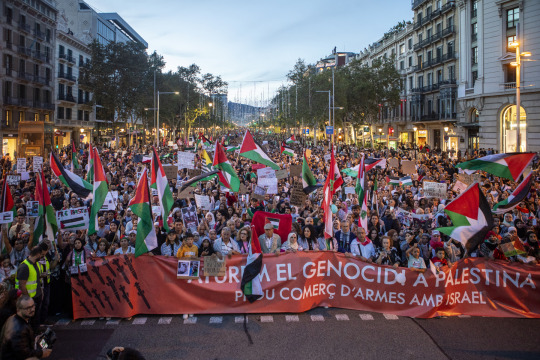
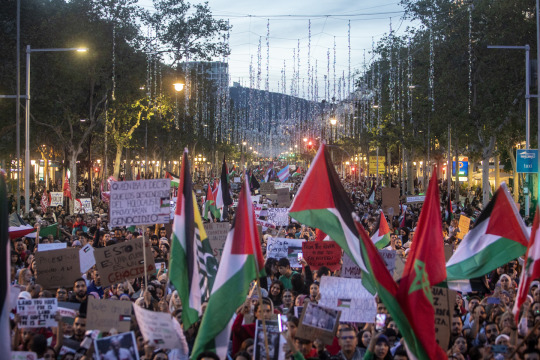


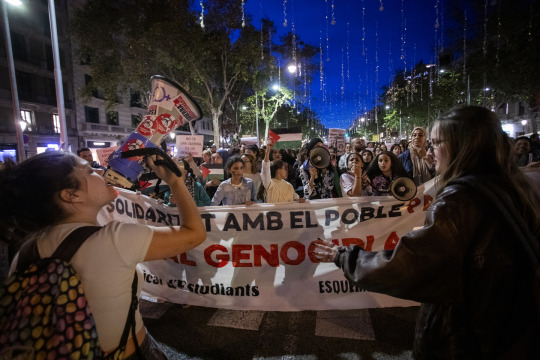
Barcelona, Catalonia. October 21st 2023.
Demonstration in solidarity with the Palestinian people, against genocide and apartheid. 🇵🇸
Photos from the newspaper La Directa.
#actualitat#palestina#palestine#catalunya#barcelona#catalonia#solidarity#free palestine#end apartheid#europe#current events#photojournalism#gaza#end genocide#other countries
1K notes
·
View notes
Text

Barcelona, Catalonia @antifastreet
#Barcelona#Catalonia#art#street art#graffiti#palestine#gaza#rafah#free palestine#freepalastine🇵🇸#middle east#lebanon#lebanese#free lebanon#ausgov#politas#auspol#tasgov#taspol#australia#fuck neoliberals#neoliberal capitalism#anthony albanese#albanese government#save palestine#palestinian genocide#i stand with palestine#all eyes on palestine#palestine genocide#free gaza
33 notes
·
View notes
Text
“True Peace” and “Total Pacifism”: the Peacecraft Ideals & the Point of it All
(buckle up, this is a long one)
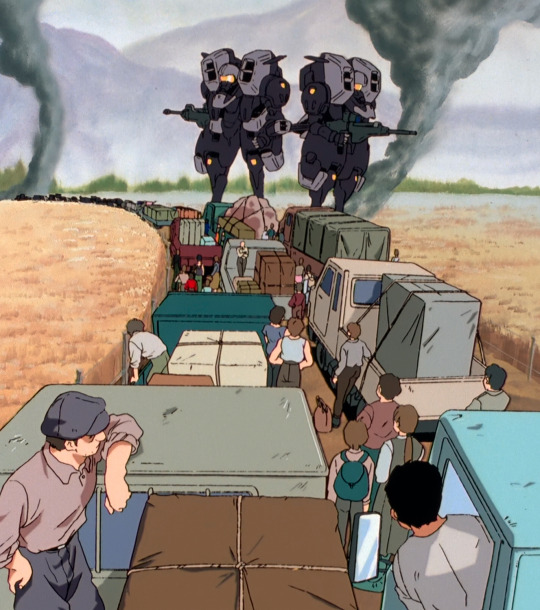
Capital “P” Peace is by far the most crucial concept in Gundam Wing.
It is a simple word that’s tossed around a lot and it pulls far too much weight for one little noun. The range of topics covered beneath this straining umbrella of a term includes everything from “a general sense of unthreatened well-being”, to “unilateral demilitarization and disbandment of global military rule”. The fault here lies not with translation difficulties or simplification for the ease of dubbing; real-world discussions of pacifism and peace are plagued by a lack of nuanced vocabulary as well. Alas, in this instance, it is the English language itself that has conspired to prank us.
Nevertheless, while overuse of the word is certainly frustrating at times, I find that when broken down and decoded, what may appear to be a lot of vague, flowery statements about the Virtues of Peace™ is actually a strategic political debate.
…Mostly. This is complicated somewhat by the fact that there are a significant number of characters for whom making flowery statements about the Virtues of War™ is a hobby and a way of life. So yes, indeed, sometimes convincing someone with Extreme Eyebrows that mankind can find value outside of eternal, violent conflict IS a priority that must be considered.
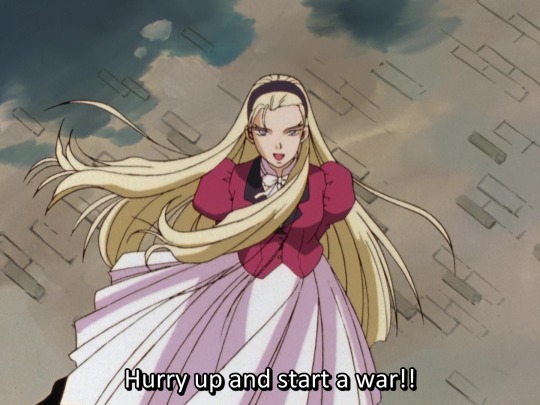
Part of why I think Gundam Wing had such a profound effect on its young audience when it came out is that it managed to cover most of an Intro to Ethics course in 49 episodes and a movie. It was a lot of kids’ first exposure to philosophy and politics, and it communicated its ideas by way of exciting robot fights and aspirationally cool characters. Gundam Wing made it easy to care about complex, abstract ideas and how they might affect the world– ideas that, at least for American audiences in the early 00’s, were well in advance of what they were likely to encounter in public school.
…Now, maybe you read that and found yourself thinking: “Come on, ‘peace is better than war’ is a pathetically simple dichotomy that no one needs to seriously debate”-- and I would love to give that to you. But as an American, I must beg you to consider that in the USA we have been trying to decide for decades whether an average of 75 school shootings per second is enough school shootings to consider implementing basic gun control.
Never underestimate the ability of a simple idea to become so polemicized that it becomes impossible to talk about or resolve without a total public paradigm shift– and now consider that learning how to cause a paradigm shift is exactly what Gundam Wing is all about.
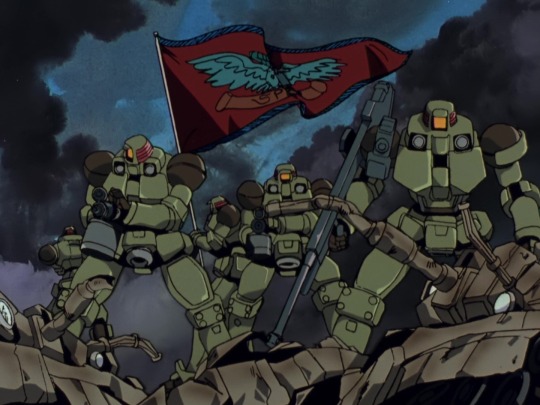
--There Is No War in A.C. 195--
For the majority of cases, when a character talks about war or peace, they mean specifically “between the Earth Sphere and the Space Colonies”-- as in, “an end to the conflict we have been embroiled in for roughly 20 years”.
This rather misleadingly makes it sound as though the Alliance is at war with the Colonies– but in AC 195, the Colonies do not have a military to go to war WITH. The Colonies aren’t engaged in a war with the Earth Sphere Alliance, they are under military occupation by the Earth Sphere Alliance.
When the Gundams first come to Earth and begin attacking the Alliance/OZ, the immediate question is: is this a declaration of war by the Colonies?
The burden continuously falls on the Colony ambassadors to prove that the Gundams are not politically associated with them. For all intents and purposes, they consider the retaliation of the Gundams to be acts of terrorism– which they must! Because otherwise they will indeed be at war with Earth, something the Colonies absolutely, 100%, definitively cannot afford. The Colonies are space bubbles. They can be popped. They can be blockaded. Earth provides the Colonies with the majority of their resources; declaring war against it would be insanity.
All this makes “peace with the Colonies” a very lopsided affair. Since officially speaking the Colonies have no military power, and since the nations of Earth that had previously allied with them were wiped out, negotiating for peace would require placing full trust in the Alliance. In other words, it would mean relying on the oppressor to stop oppressing purely as an act of goodwill.
This is why the “Peace Negotiations” proposed by the Alliance military leaders was at best a naive gesture that would have broken down at the first conflict of interest. The Alliance was responsible for the oppression of the Colonies to begin with– choosing to withdraw is a matter of their convenience; there is nothing to negotiate, because they have all the power. At worst, its “diplomacy” would simply be a farce designed to put a benevolent face on continued exploitation.
–Which is exactly what happens under OZ’s rule: “peace” is obtained in name only, while nothing about the power dynamic changes.
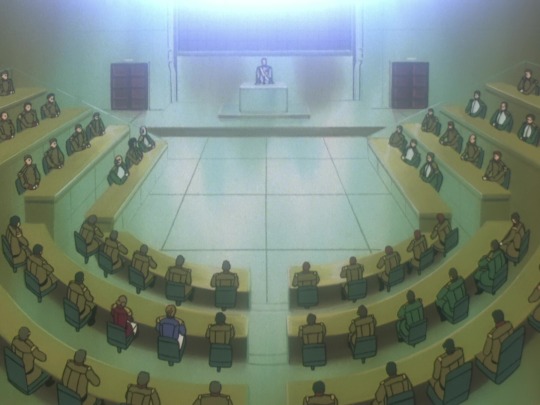
Here’s the trouble with settling for peace by any means: Every single military organization in Gundam Wing expresses a desire for world peace.
The Earth Sphere Alliance Military began as a peace-keeping measure. OZ claims it is correcting the Alliance’s failure to bring about world peace. Romefeller insists that it will bring about peace through a firm, authoritarian hand guided by the traditions of the ruling class. White Fang asserts that earth is responsible for all wars, and that peace can only be attained by destroying it.
There are many, many roads to “peace” that end in totalitarianism, to peace removed from liberty, to Pax Romefeller. In practice, White Fang’s approach would probably be the most effective at bringing about total, ever-lasting peace– if the result is all you care about, then sure, mass-extinction is one way to go!
But assuming we value peace because we ALSO value life and happiness and art and puppies and things like that, then we need to set the acceptable standard for peace somewhere above the eternal calm of a dead universe.
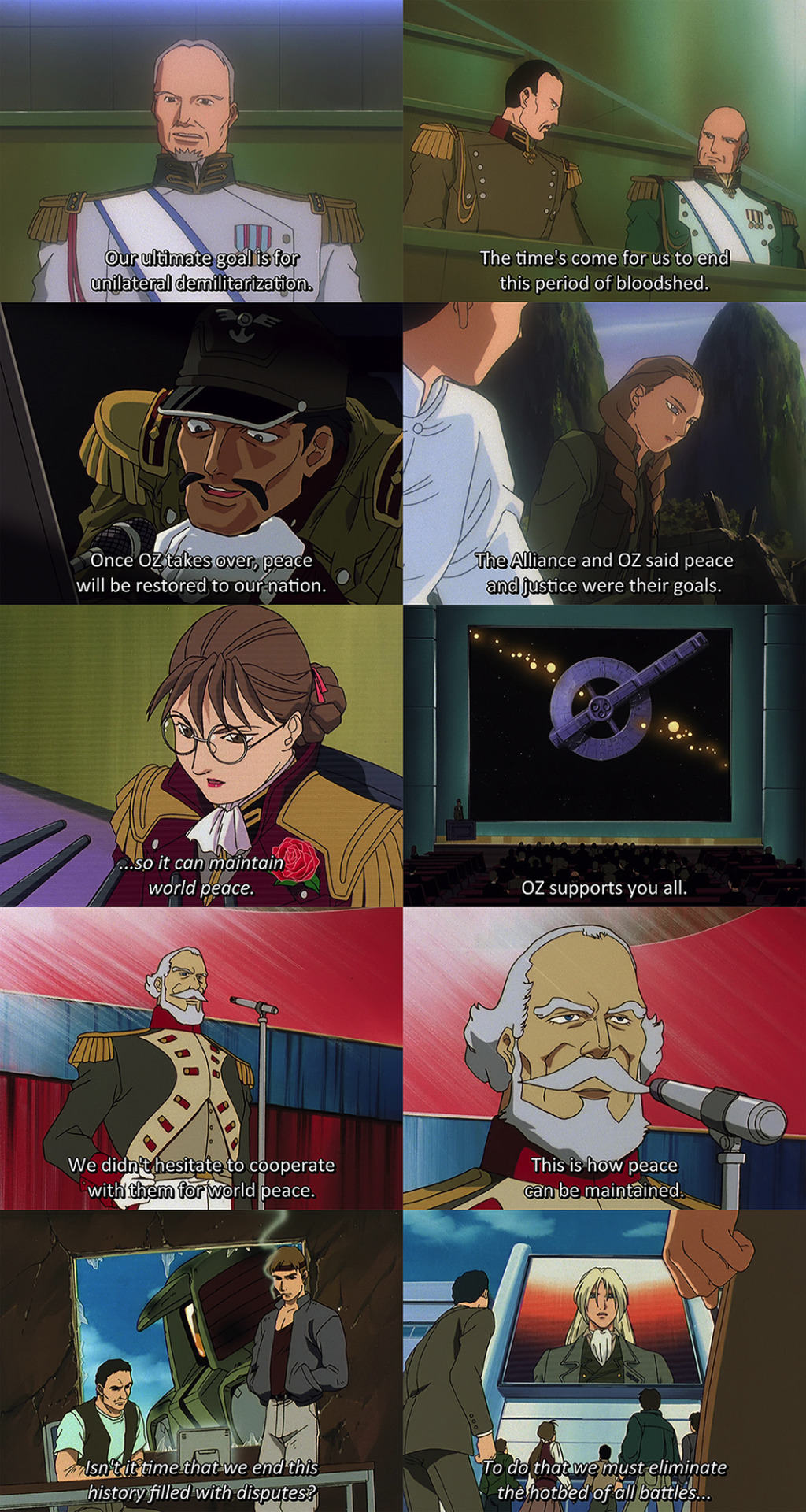
--The Peacecraft Ideals--
So, having established that “world peace by any means and any cost” is not a reasonable, humane, or moral outcome to strive for, we must consider “True Peace” to be a different outcome from “peace”.
As defined by Relena and ideals of the Sanc Kingdom, True Peace must be non-exploitative. It must require no threat of violence to enforce. To establish it, the means of military conflict must be removed and abolished, and the sources of human dispute must be addressed by means other than force of arms. Most importantly, True Peace requires fostering a transformational attitude towards peace– one that empowers the collective will of the people to both achieve and maintain peace.
To summarize, the Peacecraft plan of action is: 1) Remove weapons that are the means of military conflict, 2) Remove the primary sources of military conflict, and 3) unite people in the desire for peace, and to uphold peace.
It’s this last point that is so crucial to events that the entirety of the final narrative arc hinges upon answering the all-important questions: how does one foster the desire for peace, and bring about a massive paradigm shift that can change the course of history? and what price is one willing to pay for it?
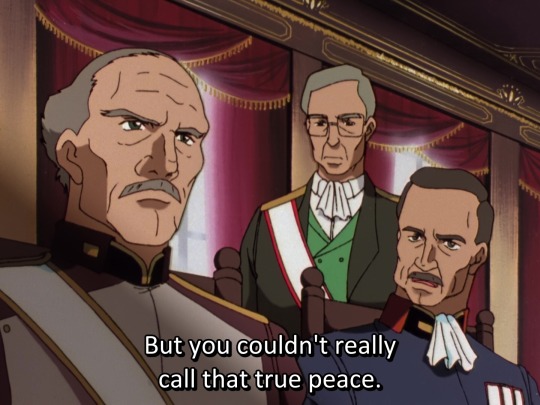
“Absolute pacifism [which is understood as a maximal and universal rejection of violence and war,] is an ideal. Some versions of absolute pacifism go so far as to abjure the idea of personal self-defense. Other absolute pacifists may allow for personal self-defense while rejecting the impersonal and political violence of war. Almost every defender of absolute pacifism recognizes the difficulty of attaining the absolute ideal.” “The world often presents us with difficult ‘kill or be killed’ choices as in the question of self-defense or war. Absolute pacifists may hold that it is better to be killed than to kill. But such a choice may be impossible for many of us to make. Pacifists will often argue that this way of describing a situation—as one where the choice is ‘kill or be killed’—usually presents us with a false dilemma: often there are other nonviolent alternatives to either killing or being killed. But when presented with such a stark choice, absolute pacifism may require self-sacrifice.” --“Pacifism”, Stanford Encyclopedia of Philosophy, Andrew Fiala, 2006
--Pulling back to real-earth for a moment: there is a wide and continuous spectrum of ethical, religious, political, and practical attitudes to be found spanning the distance between Absolute and Conditional forms of pacifism, but despite its similar name, the Total Pacifism of Gundam Wing is not a synonym for Absolute Pacifism:
There is no indication that Relena is against self-defense, nor that she insists on absolute non-violence; she’s a staunch defender of the Gundam pilots, after all, and they’re practically the face of violent resistance. She admits that in past history there were conflicts that could not have been avoided, and that one cannot maintain civilization without some degree of enforcement of principles. We can safely assume (especially after her change of heart in Endless Waltz) that she supports the proportional defensive reaction of people who are resisting oppression. But killing people is not, or at least very rarely, justifiable in her worldview (allowing for the fact that both Relena’s character and her philosophy evolve over the course of the series), and warfare never is.
“Peaceful intercourse is easily rejected by those who assert the benefits of the martial values, who claim that a war brings out the best of people and of a society, that wars heighten humanity s perception of itself in the great existentialist quest between life and death, that war relieves the monotony of consumerism and so on. This highlights one of the most difficult aspects of pacificism, that the goal of peace and of tranquility may not suffice human nature. The persistent nagging of bellicosity, of adventure, personal and collective glory, whether it derives from something genetic or culturally deeply embedded in most societies, remains an easily revitalized clarion call to war. The culture of peace is often very shallow, taking many generations to produce, and even then can be swiftly eroded with atavistic rhetoric.” --“Pacifism”, Internet Encyclopedia of Philosophy, Alexander Moseley
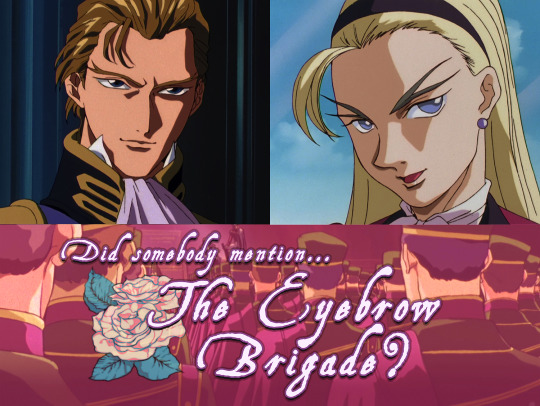
(...Remember what I said about needing to convince certain people that mankind can find value outside of eternal warfare?)
Relena’s Total Pacifism is primarily an anti-military political stance; it is only secondarily a philosophy of nonviolence. Over the course of the series, Relena confronts over and over again the notion that many people are drawn to the act of fighting for various reasons, ranging from the vindictive to the instinctual. It is not an impulse she shares or understands, but she recognizes that it exists. She is ready to admit that even within Total Pacifism, a world totally without violent desires may be impossible– but it is not necessary that people accept a world where those desires give rise to military conflict.
–Something that is worth noting is that the Peacecraft’s plan for total pacifism does not include a rubric for solving conflicts that do arise, only how they should NOT be solved.
In the series, the single method that Relena espouses for solving disputes is through “dialogue”-- something that is repeatedly pointed out to be a flawed and inadequate form of conflict resolution. “Dialogue” cannot solve all of humanity’s problems, that is unquestionably true– but neither is it a bad place to start as a baseline. More to the point, of all the possible conflicts and struggles that humanity might encounter in the vast expanse of the future, it’s futile to try and codify the best method of solving all of them based purely on abstract theory and best guesses.
Again, the Peacecraft ideal is only secondarily a philosophy; its primary goal is not to tell people HOW to solve all future problems, its goal is to solve ONE problem, and that one problem is war.
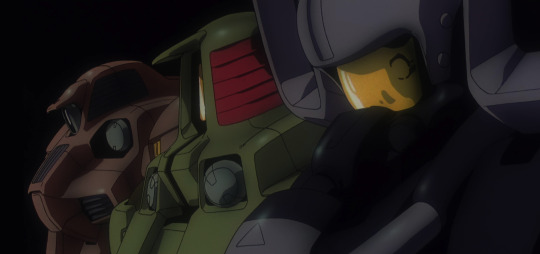
“Disarmament” Means Mobile Suits
Removing the possibility of military conflict is a preliminary for Total Pacifism, and therefore it is necessary to implement universal disarmament– and “disarmament” as it pertains to the conflicts of AC 195 means primarily the discarding and prohibition of Mobile Suits.
The reason for this is not simply because Mobile Suits are dangerous weapons. After all, Mobile Suit warfare is hardly the biggest or baddest type of war the human race has developed– leveling a city with Mobile Dolls couldn’t possibly be worse for people than leveling a city with an atomic bomb– the main thing Mobile Suits allow people to do is fight wars using infantry in space.
Not only do Mobile Suits allow for space combat, they also grant very granular control of combat zones and civilian populations without substantial risk to the troops– which is great if you’re trying to enforce military rule in the Colonies. Space fortresses and missile satellites are also threats of course, but where a missile attack would simply destroy or damage a Colony, Mobile Suits allow military forces to take direct control of it, the area around it, its resources, its populace; everything, inside and out. This is why disarmament of MS has to be a primary concern for de-escalating conflict between Earth and the Colonies: as long as Mobile Suits are still in the picture, the potential threat of domination by the Earth Sphere remains, and nobody in the Colonies is going to relax.
The Other Pacifists of A.C. 195
“Law never made men a whit more just; and, by means of their respect for it, even the well-disposed are daily made the agents of injustice. A common and natural result of an undue respect for the law is, that you may see a file of soldiers, colonel, captain, corporal, privates, powder-monkeys and all, marching in admirable order over hill and dale to the wars, against their wills, aye, against their common sense and consciences, which makes it very steep marching indeed, and produces a palpitation of the heart. They have no doubt that it is a damnable business in which they are concerned; they are all peaceably inclined. Now, what are they? Men at all? or small movable forts and magazines, at the service of some unscrupulous man in power? […]The mass of men serve the State thus, not as men mainly, but as machines, with their bodies. They are the standing army, and the militia, jailers, constables, posse comitatus, &c. In most cases there is no free exercise whatever of the judgment or of the moral sense; but they put themselves on a level with wood and earth and stones; and wooden men can perhaps be manufactured that will serve the purpose as well.” —“On the Duty of Civil Disobedience”, Henry David Thoreau
The Sanc Kingdom is not the only proponent of pacifism in the Earth Sphere.
In the Autonomous Mountain Region of former China (helluva mouthful, you'd think they'd have given themselves an actual name), for instance, we’re shown another civic leader who gathers support for demilitarization and objects to Alliance occupation. Like the Colony leader Heero Yuy and King Peacecraft before him, this unnamed leader is assassinated, and his independent nation taken over by the local branch of the Alliance military.
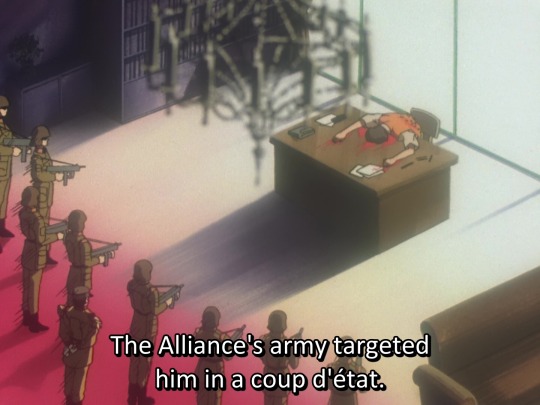
It’s only a brief footnote in the series, but it’s important because it demonstrates that the dream of pacifism is not dead on Earth, despite how often it has been violently silenced by the prevailing world order. It speaks to how powerfully the message spread by Yuy and the Sanc Kingdom resonated with people that their ideals continue to generate new martyrs; we see it also in the nations surrounding the Sanc Kingdom who are willing to stand up against Romefeller and refuse to participate in military affairs.
The existence of these nameless “Autonomous Regions” and “Independent Nations” shows us that there is at least some degree of successful resistance against the Earth Sphere government (whether that be the Alliance or OZ); it’s also clear by statements from Duke Dremail that these independent entities are considered a tremendous threat.
In a system of global military rule, to renounce the military is to essentially declare one’s withdrawal from the existing government– something that surprisingly doesn’t elicit immediate reprisal under Romefeller’s oligarchy, at least when the seceding nations offer no armed resistance.
But the rise of pacifistic nations on earth is nevertheless regarded with as much suspicion and hostility in A.C. 195 as it was during the Sanc Kingdom’s first bid for Total Pacifism, and while Romefeller, unlike the Alliance, is either unwilling or lacks the unilateral authority to quash dissenters without justification, it is more than willing to manufacture justifications to remove political rivals from the playing field. But what’s important is that they still need that manufactured justification– Romefeller, like any authority structure, requires a certain level of assent and cooperation in order to maintain power.
The practical implication of multiple countries withdrawing from the Earth Sphere and/or refusing to support the global military, is that the Earth Sphere government has fewer nations to tax and draw on for resources or support, and more places where rebel elements can take refuge. In the long run, a sufficient number of simultaneously defecting nations could mean the collapse of global military rule itself.
Armies and weapons and soldiers don’t spawn automatically on a map. Everything has to come from somewhere, and a global military organization needs to be supplied and maintained by the globe.
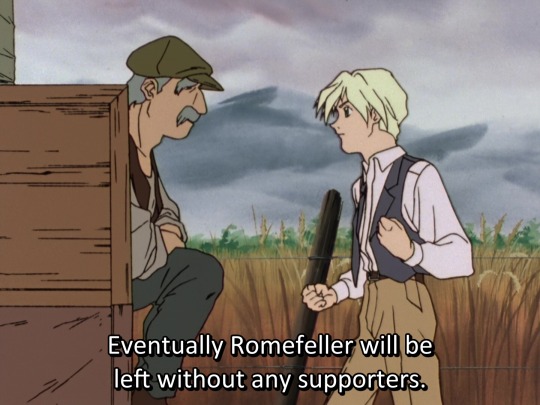
Whatever the Alliance’s policies were, it’s safe to assume that OZ/Romefeller inherited and maintained many of them, partly because they were always part of the decision making process, and also because hey, why let a perfectly good global bureaucratic infrastructure go to waste? The Alliance began as a cooperative global peace-keeping initiative; at its root, it was developed from international bureaucracy, rather than an imposed dictatorship. Even after it became the dominating world government, that underlying bureaucratic structure surely remained to some extent. National borders were still recognized, at least as an organizational convenience; the Alliance relied on taxes from the various recognized nations under their control (including the Colonies), as well as the heavily-incentivized funding of the arms industry, tied to the wealthy estates of the Romefeller Foundation, many of whose members were leaders or rulers of different nations themselves. It’s also likely there was some sort of draft for citizens of the Earth Sphere and the Colonies.
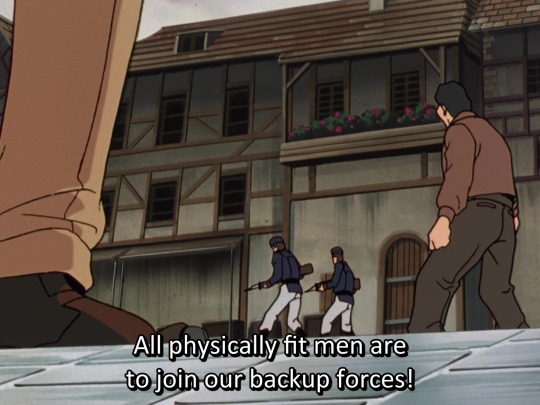
Why does this matter? Because in non-violent resistance, particularly in civil disobedience and non-compliance, it’s necessary to find ways to gain leverage that don’t involve offensive combat. In the case of resisting a military oppressor, learning what conditions allow the military to continue operating, and how to disrupt that operation, is of key importance.
Outside of Earth, we’re shown another notable example of disruptive resistance from the Winner family– adamant pacifists themselves, though their sole male heir, Quatre, broke with tradition and chose to fight against OZ using the Gundam Sandrock. The Winner family is in charge of several major natural resource satellites, a primary source of supplies for the adjacent Colonies. When those Colonies allied themselves with OZ and began arming themselves in spite of their past commitment to pacifism, and in spite of OZ’s quite recent manipulative and violent suppression of the Colonies, the Winner family patriarch protested this move vehemently. When it was clear the now-militarizing Colony would continue supporting OZ and intended to begin manufacturing weapons on the natural resources satellite, Mr. Winner removed his support from the Colony– both ideologically and physically, by decoupling the resource satellite; a move that cost him his life at the hands of OZ.
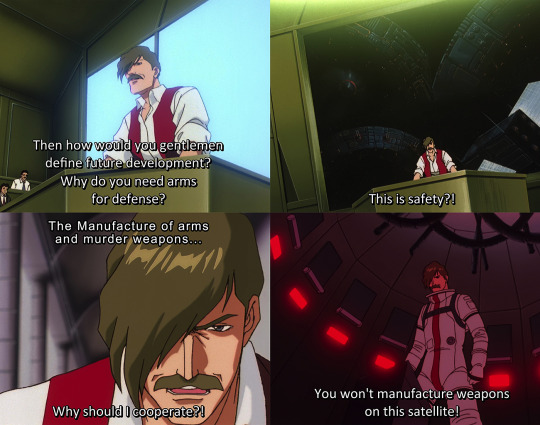
A Glass Kingdom Throws No Stones
The Sanc Kingdom’s existence is based on hope.
It assumes peace (i.e. a state of goodwill and non-conflict) is the natural state humanity longs for, the only condition it can truly flourish in, and therefore it is in everyone’s best interest to pursue. Even those who advocate in favor of war would eventually see the pragmatic benefit of peace– wars are costly, and demand a constant supply of resources and humans to throw into it. If everyone simply acknowledged these truths, True Peace ought to be the inevitable outcome.
This position is largely (but not universally) viewed as naive, idealistic, and ultimately hopeless. Even its proponents acknowledge that the Sanc Kingdom’s ideals are built on trust and air– but they maintain that their belief in that trust is nevertheless of utmost value, for inspiring others to realize what might be possible if that trust were universal.
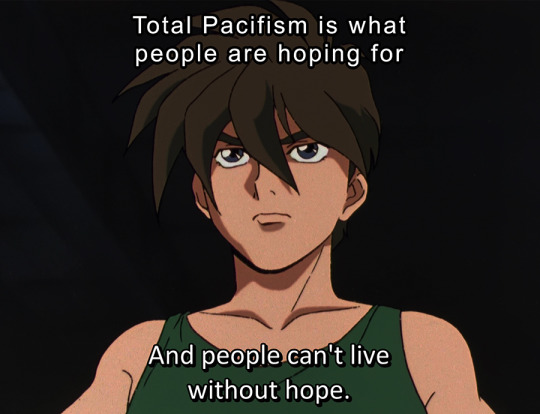
The Sanc Kingdom’s one defense is its total lack of offense. By removing itself as a potential threat and offering no resistance or antagonism to the ruling power, it minimizes the incentive for that ruling power to overrun and destroy it– but there are no guarantees.
Relena pragmatically warns her students that the Sanc Kingdom will never be a safe place until Total Pacifism is adopted globally. She herself is prepared for the likely scenario that advocating for peace will cost her her life. The tenuousness of the kingdom’s position is fully acknowledged by all– how could it not be? The current Sanc is built on the ruins of the previous generation’s bid for pacifism.
Despite this, the kingdom’s doors are open to all; Relena maintains a supremely generous view of mankind that gives everyone the benefit of doubt, continuing within the same logic that non-aggression will be met with non-aggression. Perhaps more accurately, this policy is her way of insisting that this is how peaceful interactions ought to be; despite the considerable risk they incur, both she and her kingdom stand defenseless in a world of grasping military powers, wielding only her dignity, her public visibility, and a conviction that everyone is capable of choosing respectful conduct.
The Sanc Kingdom is perfectly set up for martyrdom– and it is a very short ride before it gets there.
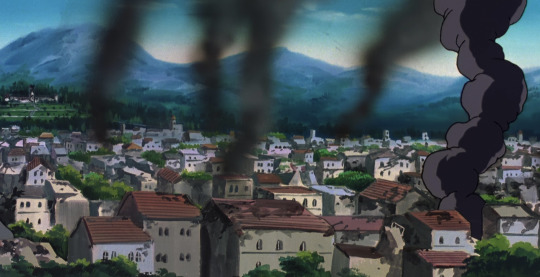
But the power of Relena’s ideals is not tied to the existence of the Sanc Kingdom– it’s not even tied to her, or the Peacecraft name. The naivety, the impossibility, of pacifism in an era defined by global military rule, is constantly reiterated, and yet it does not disappear.
Even as the bottleneck of war grows tighter and the violence between the ever-fragmenting world powers continues to escalate, the majority of people bearing witness to these horrors look to an alternative that offers hope, as practiced and advocated by a brave girl facing impossible odds.
The more pitched the violence becomes, the louder its perpetrators shout that peace is impossible, while to the people suffering its effects, the more outrageous and unnecessary that violence is revealed to be. The ones waging the wars seem to be the ones generating new reasons for them, their excuses becoming increasingly absurd, their justifications transparently thin.
Is it really so absurd or unreasonable by comparison, to take part in an actionable plan for peace?
“I’m aware that my views may appear to be a little naive to some people, but I wonder why people battle if everyone agrees that it’s foolish to do so? I don’t think that we’re too far from the answer.”
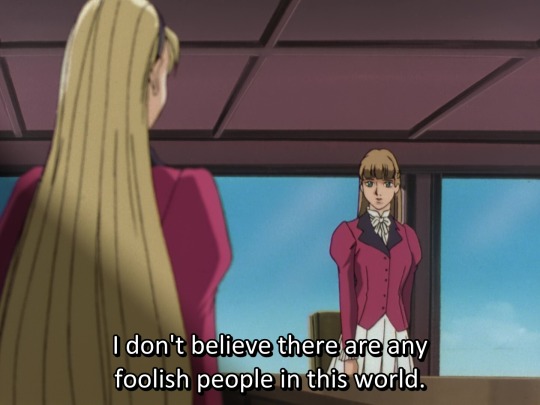
#Gundam Wing#Relena Peacecraft#Sanc Kingdom#After Colony#Gundam Wing Meta#Dorothy Catalonia#Romefeller Eyebrow Brigade#gundam wingtionary#wing watcher's toolkit#parsing post#i can't believe this entry is finally done hallelujah i'm free
85 notes
·
View notes
Text
الصمت هو التواطؤ، فلنوقف الإبادة الجماعية
مولينس دي ري، كتالونيا

"Silence is complicit, let's stop the genocide"
Seen in Molins de Rei, Catalonia
#Molins de Rei#Catalonia#مولينس دي ري#كتالونيا#palestine#free palestine#gaza#free gaza#جداريات#graffiti#street art#جدران#فلسطین#فلسطين#فلسطين حرة#الحرية لغزة#غزة#الحرية لفلسطين
258 notes
·
View notes
Text
Check out my Barcelona collection on Shutterstock
#architecture#architettura#photooftheday#photography#barcelona spain#barcelona femeni#fc barcelona#barcelona could release robert lewandowski on free transfer as bizarre contract clause is revealed#barcelona ‘to raid premier league after gavi ruled out for season with liverpool and spurs stars on their radar’#catalunya#catalonia#cataluña#spain#spain women's national team#españa
0 notes
Text

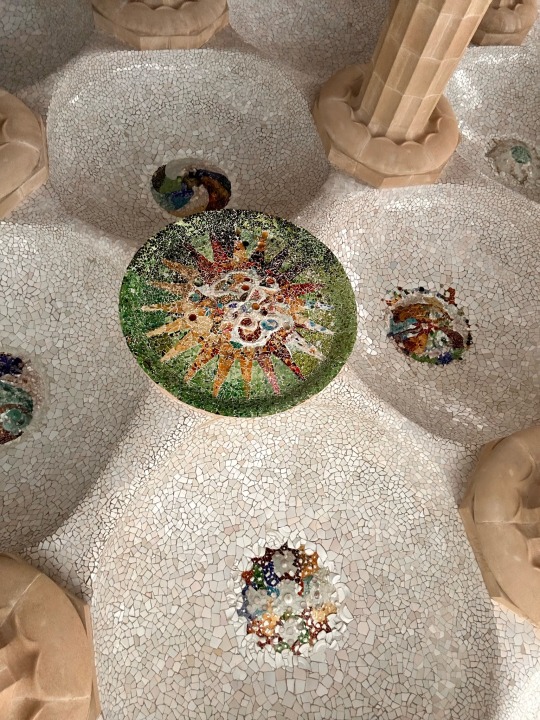

Park Güell, Barcelona, Catalonia, Spain (03.01.2023)
#photography#aesthetic#stunning#so pretty#park#park guell#antoni gaudi#gaudism#gaudi#outside#tourist#spain#catalonia#structure#ceiling#the wave#free masons#Illuminati#ancient mosaic#mosaic#tiles#Barcelona#wood#stone
1 note
·
View note
Text
"Spain’s Catalonia region rolled out a pioneering women’s health initiative [at the beginning of March, 2024] that offers reusable menstruation products for free.
About 2.5 million women, girls, transgender and nonbinary people who menstruate can receive one menstrual cup, one pair of underwear for periods and two packages of cloth pads at local pharmacies in northeast Spain free of charge.
The Catalan government said that the initiative, which is called “My period, my rules,” was meant to “guarantee the right to menstrual equity.” The regional government cited statistics that said 23% of women polled by Catalonia’s public opinion office said they had reused hygiene products designed for a single use for economic reasons.
Tània Verge, Catalonia’s regional minister for equality and feminism, called the program a “global first.”
Scotland’s government passed a law in 2020 to ensure period products are available for free to anyone who needs them. But in comparison with the Catalan program, in Scotland the products are for single use and are distributed through schools, colleges and universities, not pharmacies.
“We are fighting menstrual poverty, which affects one in four women in Catalonia, but is also about gender justice. We are fighting the stereotypes and taboos about menstruation,” Verge told The Associated Press. “And (...) it is about climate justice. We need to reduce the tons of waste generated by single-use menstrual products.”
The distribution of reusable products is also aimed at reducing waste. The regional government said that Catalonia produces about 9,000 tons of waste from single-use menstrual hygiene products.
The reusable products are acquired by the public health care system, which covers the entire population, and distributed by Catalonia’s 3,000-plus private pharmacies. The program cost the regional government 8.5 million euros ($9.2 million).
“I am completely in favor of this initiative,” 29-year-old graphic designer Laura Vilarasa said. “It will give women a product that is absolutely necessary to have for zero cost.”
Spain’s national government passed a law last year granting women with debilitating menstrual pain the right to paid medical leave."
-via AP News, March 5, 2024
#periods#menstrual cycle#menstrual health#menstruation#period poverty#period products#spain#catalonia#waste#women#womens rights#transgender#nonbinary#period underwear#menstrual cup#reusable#reusable pads#good news#hope#feminism#gender equality
289 notes
·
View notes
Text
Hi, I'm a writer from Catalonia, Spain, and since Trump won the election I wanted to do something for the trans people out there. Of course, I can't do so much, but since I'm a writer, I decided to write a book called "Their Voices" in English, Spanish, and Catalan about the stories of trans people around the world. And since it's about trans people, I want to ask you that if you want to participate/be in my book, you can!
You can explain ANYTHING you want about your trans experience and you'll be in the book HOWEVER you want. Do you want to be anonymous? Great. Do you want to use a nickname/pseudonym? Great. Do you want to use your name(s)? Great. It's also okay if you want to say where you're from or not. Or if you want to say, I don't know, for example, I'm from Florida or the US, it's your choice.
Also, and of course, who participate will have a free copy!
Don't give up. I want to hear YOUR voice.
76 notes
·
View notes
Text
Catalan pharmacies hand out free reusable period products | Catalonia | The Guardian
The Catalonia region in Spain has begun providing free reusable menstrual cups, period underwear and cloth pads at pharmacies, in one of the first initiatives of its kind in the world.
The programme is part of a drive by the regional government to reduce period poverty after a survey found 44% of women using menstruation products in Catalonia could not afford their first-choice product and 23% said they had to reuse items designed for single use.
159 notes
·
View notes
Text
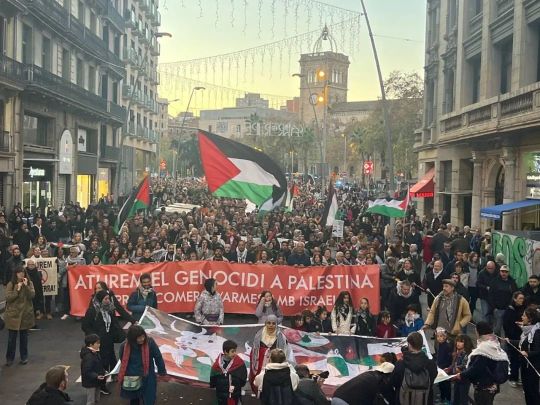


Yesterday 16th December 2023, yet another demonstration in Barcelona (Catalonia) calling for the end of Israel's genocide of the Palestinian people, for Europe to stop buying and selling weapons with Israel, and for the end of apartheid.
To pressure the Government of Catalonia to stand their ground and join the Boycott, Divestment and Sanctions campaign against Israel, the demonstration ended with a gathering in front of the Government of Catalonia where the protestors played the sounds that people of Gaza hear:
This long white paper is the list of names of the Palestinians who have been killed by Israel since October.
The banners they hold mean "Stop the genocide in Palestine. End arms trade with Israel" in the Catalan language.
Photos and videos posted by Prou Complicitat amb Israel, organization of Catalan people in solidarity with Palestine.
#palestina#palestine#free palestine#gaza#solidarity#catalunya#barcelona#catalonia#death tw#war tw#other countries
326 notes
·
View notes
Text

INTERVIEW WITH A WRITEBLR — @vsnotresponding
Who You Are:
V || They/she
Born and raised in a town in Catalonia, Spain. I always had an interest for stories and storytelling, and art in general, as well as math. I wrote my first book at 17 as my project to graduate high school. I'm currently majoring in math, translating said book, and plotting another one.
What You Write:
What genres do you write in? What age ranges do you write for?
Fantasy, Paranormal, Sci-Fi, Tragedy. Young and New Adult
What genre would you write in for the rest of your life, if you could? What about that genre appeals to you?
fantasy, mainly because i love worldbuilding and i often focus on religions or magic systems
What genre/s will you not write unless you HAVE to? What about that genre turns you off?
i don't think i could ever write a purely romance book. my aroaceness makes it very hard for me to write romance in general.
Who is your target audience? Do you think anyone outside of that would get anything out of your works?
i'm not really sure. i write mostly for me. probably just soft fantasy readers? i think people that enjoy worldbuilding and lore might enjoy my stories too. i think anyone could get something out of my books. the setting is just an excuse to write about other things at the end of the day
What kind of themes do you tend to focus on? What kinds of tropes? What about them appeals to you?
grief and circular time appeal the most to me, also main characters struggling with mental health, feeling displaced and out of place. as for tropes, found family and people who dislike each other forced to work together. i don't know why grief comes up that much in my stories. i am obsessed with thinking about circular time, tho. and the mental health issues of my main characters is mostly projecting. as for the tropes, it's all about finding your people whom you feel like yourself with.
What themes or tropes can you not stand? What about them turn you off?
i can deal with pretty much any trope as long as it's entertaining. certain styles of writing is what ultimately turn me off when reading.
What are you currently working on? How long have you been working on it?
i'm currently translating and posting púlsar, i book i wrote when i was 17. i've been translating for three months, and posting for one. i'm also working on untitled project (that's the actual name for the wip), figuring out plot details and that kinda things. i've been doing that since 2019, when UP was born
Why do you write? What keeps you writing?
i write because i am my own target audience, and because i want to tell my ocs' stories. that's what keeps me going too. i can't just be rid of them, they live rent free in my brain
How long have you been writing? What do you think first drew you to it?
since forever, i guess. i remember writing stories as a kid. i was also an avid reader, and a lonely only child that was left alone to their own devices too often, so i found ways to entertain myself
Where do you get your inspiration from? Is that how you got your inspiration for your current project? If not, where did the inspiration come from?
from my daily life, i guess. púlsar doesn't have that many sources of inspiration that i'm aware of, but UP has lots of influences from my philosophy classes from back in high school. in general, music helps a lot with how i approach my writing.
What work of yours are you most proud of? Why?
some short stories i wrote in high school. they are all writing assignments, but i went so hard on them they are still one of the bests things i've ever written. also my answer to a question in my philosophy final, which i later turned into a short story. circular time, man, i told you
Have you published anything? Do you want to?
i haven't, but i'd like to. i just want to share my worlds and characters with other people
What part of the publishing process most appeals to you? What part least appeals to you?
the sharing, but i also think it's very stressful
What part of the writing process most appeals to you? What part is least appealing?
putting it all together. i love finding out how i've unintentionally set up scenes i hadn't even thought about, or how unimportant details turn vital when i add a new scene
Do you have a writing process? Do you have an ideal setup? Do you write in pure chaos? Talk about your process a bit.
oh boy. my writing process is a mess. it's mostly non linear, and i sit with my stories for a long long time before ever starting to write. i also pull from my drawings. sometimes i'll randomly draw one oc doing something completely arbitrary, and then see that it actually fits with the plot so why not add it. generally, i have a very rough direction of where i want to go, 2 or 3 key scenes i know for sure have to happen, then i put the characters in A Situation and let them take the reins from there. because i've sit with them for so long before actually writing, i'm confident enough in my knowledge of them so i never doubt where they are going, they just go. usually i plan ahead for two or three chapters, mostly a bullet point summary or an explanation of events for UP it's been way more complicated because of the nature of the story and its non linearity
Your Thoughts on Writeblr:
How long have you been a writeblr? What inspired you to join the community?
i joined four months ago. i just wanted to share my work with other like minded people, and i'm honestly glad i did. i've met so many wonderful people in such a short amount of time, and the community is wonderful
Shout out some of your favorite writeblrs. How did you find them and what made you want to follow them?
i recently started following @mjjune. i simply fell in love with their now betaing twtr and their general vibes @moondust-bard has also created a bunch of writblr initiatives like a tag game list, and other ongoing projects and i have to mention @my-cursed-prince. she asked me a lot of questions about circular time, and then i checked out her wips and adopted her ocs on the spot
What is your favorite part about writeblr?
tag/asks games, and in general the community. i like sharing, sure, but it's also nice to be able to talk about worlbuilding and lore and how annoying ocs sometimes are with people that get it
What do you think writeblr could improve on? How do you think we can go about doing so?
huh, i'm not sure. more interaction with actual written stuff would be great, but everyone's busy with their lives outside of here so we can't ask of everyone to read everything that comes across their dashboards every day. it'd be great to have an easy to access place to check old and new writing without having to go to an individual blog every time, but that's also a time consuming project to manage
How do you contribute to the writeblr community? Do you think you could be doing more?
if i see someone asking for asks i always send one. i also try to be encouraging of others as much as i can. i do think i could be doing much more. for starters, i'd like to engage more with written content from other writblrs more, but i can't due to time constraints
What kinds of posts do you most like to interact with?
anything that strikes my fancy. i enjoy posts about the writing process struggles people have, or little thoughts they have as they write or plot
What kind of posts do you most like to make?
i love rambling when someone asks me a question. and also posting púlsar
Finally, anywhere else online we may be able to find you?
i have a half abandoned instagram art account with the same handle (vsnotresponding), and my main tumblr blog @iwrotemyowndeliverancesblog (i talk about maths and complain about life)
17 notes
·
View notes
Text
"I immediately got involved in the ongoing socialization process. My group, the one that had occupied the barracks, immediately created a food depot, open to all, in the neighborhood where I lived. We assesed consumption needs and, subsequently, we intervened with certain workshops to intensify production. For example, I, who knew how to make bread, remember going, in the midst of a shooting, to help out at the neighborhood bakery. We were very imbued with the Kropotkinian idea - developed in The Conquest of Bread - according to which any revolution which proves incapable of feeding the people is lost in advance.
From there, we got our hands on all the grocery stores and warehouses in the neighborhood and we would go to the surrounding villages to exchange industrial products for foodstuffs. It was not a question of robbing the peasants, but of making them understand that we needed eggs and milk for the wounded in the hospitals. Knowing that the Catalan peasants are a little selfish, and being armed with our weapons, we could have proceeded authoritatively, but we would only have gained their antipathy. So we brought fabrics, canned goods and anything else they needed and exchanged them for chickens, potatoes and beans, which we loaded into our trucks. In the neighborhood, the products of the grocery stores, whose owners had been driven out, were centralized in a single place, where the people were invited to help themselves freely.
And how did it work?
Money having been abolished, the distribution of edibles was organized in the neighborhood on the basis of tickets, but they were only used for very specific items. For essential foodstuffs, all you had to do was go to the central grocery store and help yourself. We had, of course, a surveillance service responsible for spotting and investigating hoarders. I happened to go, one day, myself, to a lady who we were told had bread and bags of potatoes in quantity, which was true. There were controls. The market was free, open, but no abuse was tolerated.
A week after this system was put in place, an official from the regional committee of Catalonia visited us and, as he knew me, he began to explain to me how we should organize ourselves:
- It is essential, he told me, to create supply commissions to organize supplies...
I started laughing, and took him into the collective store.
- Look, that’s exactly what we did, without waiting for you...
In fact, the initiative returned to the people, without slogans or oders. They took the lead, without even the intervention of the CNT authorities. The workers had collectivized spontaneously, occupying the workshops of their own accord and putting them back into operation. The CNT did nothing other than confirm what had happened and which, for a lot of it, had been the work of their militants. The committees, too, were overwhelmed and waiting. This was, on my small scale, my experience in the field of collectivization."
-"Un entretien avec José Peirats" (1976)
8 notes
·
View notes
Text

A.5 What are some examples of “Anarchy in Action”?
A.5.6 Anarchism and the Spanish Revolution
As Noam Chomsky notes, “a good example of a really large-scale anarchist revolution — in fact the best example to my knowledge — is the Spanish revolution in 1936, in which over most of Republican Spain there was a quite inspiring anarchist revolution that involved both industry and agriculture over substantial areas … And that again was, by both human measures and indeed anyone’s economic measures, quite successful. That is, production continued effectively; workers in farms and factories proved quite capable of managing their affairs without coercion from above, contrary to what lots of socialists, communists, liberals and other wanted to believe.” The revolution of 1936 was “based on three generations of experiment and thought and work which extended anarchist ideas to very large parts of the population.” [Radical Priorities, p. 212]
Due to this anarchist organising and agitation, Spain in the 1930’s had the largest anarchist movement in the world. At the start of the Spanish “Civil” war, over one and one half million workers and peasants were members of the CNT (the National Confederation of Labour), an anarcho-syndicalist union federation, and 30,000 were members of the FAI (the Anarchist Federation of Iberia). The total population of Spain at this time was 24 million.
The social revolution which met the Fascist coup on July 18th, 1936, is the greatest experiment in libertarian socialism to date. Here the last mass syndicalist union, the CNT, not only held off the fascist rising but encouraged the widespread take-over of land and factories. Over seven million people, including about two million CNT members, put self-management into practise in the most difficult of circumstances and actually improved both working conditions and output.
In the heady days after the 19th of July, the initiative and power truly rested in the hands of the rank-and-file members of the CNT and FAI. It was ordinary people, undoubtedly under the influence of Faistas (members of the FAI) and CNT militants, who, after defeating the fascist uprising, got production, distribution and consumption started again (under more egalitarian arrangements, of course), as well as organising and volunteering (in their tens of thousands) to join the militias, which were to be sent to free those parts of Spain that were under Franco. In every possible way the working class of Spain were creating by their own actions a new world based on their own ideas of social justice and freedom — ideas inspired, of course, by anarchism and anarchosyndicalism.
George Orwell’s eye-witness account of revolutionary Barcelona in late December, 1936, gives a vivid picture of the social transformation that had begun:
“The Anarchists were still in virtual control of Catalonia and the revolution was still in full swing. To anyone who had been there since the beginning it probably seemed even in December or January that the revolutionary period was ending; but when one came straight from England the aspect of Barcelona was something startling and overwhelming. It was the first time that I had ever been in a town where the working class was in the saddle. Practically every building of any size had been seized by the workers and was draped with red flags or with the red and black flag of the Anarchists; every wall was scrawled with the hammer and sickle and with the initials of the revolutionary parties; almost every church had been gutted and its images burnt. Churches here and there were being systematically demolished by gangs of workman. Every shop and cafe had an inscription saying that it had been collectivised; even the bootblacks had been collectivised and their boxes painted red and black. Waiters and shop-walkers looked you in the face and treated you as an equal. Servile and even ceremonial forms of speech had temporarily disappeared. Nobody said ‘Señor’ or ‘Don’ or even ‘Usted’; everyone called everyone else ‘Comrade’ or ‘Thou’, and said ‘Salud!’ instead of ‘Buenos dias’… Above all, there was a belief in the revolution and the future, a feeling of having suddenly emerged into an era of equality and freedom. Human beings were trying to behave as human beings and not as cogs in the capitalist machine.” [Homage to Catalonia, pp. 2–3]
The full extent of this historic revolution cannot be covered here. It will be discussed in more detail in Section I.8 of the FAQ. All that can be done is to highlight a few points of special interest in the hope that these will give some indication of the importance of these events and encourage people to find out more about it.
All industry in Catalonia was placed either under workers’ self-management or workers’ control (that is, either totally taking over all aspects of management, in the first case, or, in the second, controlling the old management). In some cases, whole town and regional economies were transformed into federations of collectives. The example of the Railway Federation (which was set up to manage the railway lines in Catalonia, Aragon and Valencia) can be given as a typical example. The base of the federation was the local assemblies:
“All the workers of each locality would meet twice a week to examine all that pertained to the work to be done... The local general assembly named a committee to manage the general activity in each station and its annexes. At [these] meetings, the decisions (direccion) of this committee, whose members continued to work [at their previous jobs], would be subjected to the approval or disapproval of the workers, after giving reports and answering questions.”
The delegates on the committee could be removed by an assembly at any time and the highest co-ordinating body of the Railway Federation was the “Revolutionary Committee,” whose members were elected by union assemblies in the various divisions. The control over the rail lines, according to Gaston Leval, “did not operate from above downwards, as in a statist and centralised system. The Revolutionary Committee had no such powers… The members of the… committee being content to supervise the general activity and to co-ordinate that of the different routes that made up the network.” [Gaston Leval, Collectives in the Spanish Revolution, p. 255]
On the land, tens of thousands of peasants and rural day workers created voluntary, self-managed collectives. The quality of life improved as co-operation allowed the introduction of health care, education, machinery and investment in the social infrastructure. As well as increasing production, the collectives increased freedom. As one member puts it, “it was marvellous … to live in a collective, a free society where one could say what one thought, where if the village committee seemed unsatisfactory one could say. The committee took no big decisions without calling the whole village together in a general assembly. All this was wonderful.” [Ronald Fraser, Blood of Spain, p. 360]
We discuss the revolution in more detail in section I.8. For example, sections I.8.3 and I.8.4 discuss in more depth how the industrial collectives. The rural collectives are discussed in sections I.8.5 and I.8.6. We must stress that these sections are summaries of a vast social movement, and more information can be gathered from such works as Gaston Leval’s Collectives in the Spanish Revolution, Sam Dolfgoff’s The Anarchist Collectives, Jose Peirats’ The CNT in the Spanish Revolution and a host of other anarchist accounts of the revolution.
On the social front, anarchist organisations created rational schools, a libertarian health service, social centres, and so on. The Mujeres Libres (free women) combated the traditional role of women in Spanish society, empowering thousands both inside and outside the anarchist movement (see The Free Women of Spain by Martha A. Ackelsberg for more information on this very important organisation). This activity on the social front only built on the work started long before the outbreak of the war; for example, the unions often funded rational schools, workers centres, and so on.
The voluntary militias that went to free the rest of Spain from Franco were organised on anarchist principles and included both men and women. There was no rank, no saluting and no officer class. Everybody was equal. George Orwell, a member of the POUM militia (the POUM was a dissident Marxist party, influenced by Leninism but not, as the Communists asserted, Trotskyist) makes this clear:
“The essential point of the [militia] system was the social equality between officers and men. Everyone from general to private drew the same pay, ate the same food, wore the same clothes, and mingled on terms of complete equality. If you wanted to slap the general commanding the division on the back and ask him for a cigarette, you could do so, and no one thought it curious. In theory at any rate each militia was a democracy and not a hierarchy. It was understood that orders had to be obeyed, but it was also understood that when you gave an order you gave it as comrade to comrade and not as superior to inferior. There were officers and N.C.O.s, but there was no military rank in the ordinary sense; no titles, no badges, no heel-clicking and saluting. They had attempted to produce within the militias a sort of temporary working model of the classless society. Of course there was not perfect equality, but there was a nearer approach to it than I had ever seen or that I would have though conceivable in time of war… “ [Op. Cit., p. 26]
In Spain, however, as elsewhere, the anarchist movement was smashed between Stalinism (the Communist Party) on the one hand and Capitalism (Franco) on the other. Unfortunately, the anarchists placed anti-fascist unity before the revolution, thus helping their enemies to defeat both them and the revolution. Whether they were forced by circumstances into this position or could have avoided it is still being debated (see section I.8.10 for a discussion of why the CNT-FAI collaborated and section I.8.11 on why this decision was not a product of anarchist theory).
Orwell’s account of his experiences in the militia’s indicates why the Spanish Revolution is so important to anarchists:
“I had dropped more or less by chance into the only community of any size in Western Europe where political consciousness and disbelief in capitalism were more normal than their opposites. Up here in Aragon one was among tens of thousands of people, mainly though not entirely of working-class origin, all living at the same level and mingling on terms of equality. In theory it was perfect equality, and even in practice it was not far from it. There is a sense in which it would be true to say that one was experiencing a foretaste of Socialism, by which I mean that the prevailing mental atmosphere was that of Socialism. Many of the normal motives of civilised life — snobbishness, money-grubbing, fear of the boss, etc. — had simply ceased to exist. The ordinary class- division of society had disappeared to an extent that is almost unthinkable in the money-tainted air of England; there was no one there except the peasants and ourselves, and no one owned anyone else as his master… One had been in a community where hope was more normal than apathy or cynicism, where the word ‘comrade’ stood for comradeship and not, as in most countries, for humbug. One had breathed the air of equality. I am well aware that it is now the fashion to deny that Socialism has anything to do with equality. In every country in the world a huge tribe of party-hacks and sleek little professors are busy ‘proving’ that Socialism means no more than a planned state-capitalism with the grab-motive left intact. But fortunately there also exists a vision of Socialism quite different from this. The thing that attracts ordinary men to Socialism and makes them willing to risk their skins for it, the ‘mystique’ of Socialism, is the idea of equality; to the vast majority of people Socialism means a classless society, or it means nothing at all … In that community where no one was on the make, where there was a shortage of everything but no boot-licking, one got, perhaps, a crude forecast of what the opening stages of Socialism might be like. And, after all, instead of disillusioning me it deeply attracted me…” [Op. Cit., pp. 83–84]
For more information on the Spanish Revolution, the following books are recommended: Lessons of the Spanish Revolution by Vernon Richards; Anarchists in the Spanish Revolution and The CNT in the Spanish Revolution by Jose Peirats; Free Women of Spain by Martha A. Ackelsberg; The Anarchist Collectives edited by Sam Dolgoff; “Objectivity and Liberal Scholarship” by Noam Chomsky (in The Chomsky Reader); The Anarchists of Casas Viejas by Jerome R. Mintz; and Homage to Catalonia by George Orwell.
#community building#practical anarchy#practical anarchism#anarchist society#practical#faq#anarchy faq#revolution#anarchism#daily posts#communism#anti capitalist#anti capitalism#late stage capitalism#organization#grassroots#grass roots#anarchists#libraries#leftism#social issues#economy#economics#climate change#climate crisis#climate#ecology#anarchy works#environmentalism#environment
8 notes
·
View notes
Text

"Together we will break free! / Feminism is the radical idea that women are people"
Feminist mural featuring Angela Davis spotted in Cadaques, Catalonia, Spain
219 notes
·
View notes